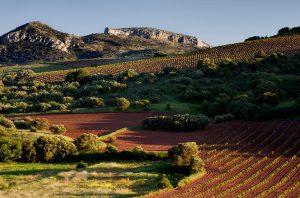Garnacha has been experiencing an exciting revival. As familiarity with this magnificent red variety grows among consumers, better site selection, viticulture and winemaking continue to transform its potential.
Pioneering, collective power
As a pioneering winery, Bodegas Borsao has played a decisive role in Garnacha’s comeback. Beginning as a cooperative of winegrowers in 1958, Borsao became a fully fledged company in 2001, uniting 375 growers in their mission to produce terroir-driven wines that offer both tremendous value and superlative quality.
Today they cultivate over 2,100 hectares, with an average yield of 2,500 – 4,000 kilos per hectare, in the arid landscape of Campo de Borja, northwest of Zaragoza – one of the most exciting regions to rise to prominence in recent times – against the backdrop of the imposing Moncayo mountain.
A meeting of contrasts
The region has a dual climate: Atlantic winds provide a moderating influence while the Mediterranean brings warmer temperatures. These opposing influences collide over the D.O. Extreme temperatures and a wide thermal amplitude – both a large diurnal range and variation between summer and winter temperatures – help to achieve good acidity, beautiful colour and pleasant tannins in the wines.
The range of terroirs and mesoclimates has no equal in Eastern Spain: vineyards planted at low-lying elevations thrive on brown limestone and sand-rich soils, while the slopes of Moncayo are rich in red slate and lime. The continental climate is moderated by the ‘Cierzo’, a cold, dry northwestern wind that helps to cool vine canopies in the summer.
Working alongside nature
Low rainfall (an annual average of 250 – 300 mm) influences the development of the vine; the vines experience water stress but also find groundwater. To enable this, Borsao leaves extra space between vines to allow the roots to spread. A large majority of Borsao’s vines are dry-farmed, with only minimal irrigation in small areas, or for young vines other than Garnacha, to establish healthy growth. In addition, over 100 hectares are being prepared by Borsao’s sustainability committee to produce sustainable wines.
Alongside its environmental benefits, Borsao believes dry farming improves the quality of the wine. When dry-farmed, the vines must work harder to find the right amount of water. This early struggle trains the vines for their water intake needs and drives them to develop a deeper root system, which in turn produces a deeper flavour profile: minerality with complex yet gentle tannin structure, and a higher concentration of polyphenols.
Contrast and balance
As well as this, elevation is a crucial factor in Campo de Borja viticulture. The accessible slopes of Moncayo rise to 850 metres above sea level, and in these mountain vineyards, the nights are as cool as the days are hot. The result is perfumed and juicy Garnacha wines that effortlessly combine freshness with Mediterranean ripeness in sun-drenched Aragon.
At lower altitudes, meanwhile, vines yield concentrated berries, producing very potent red wines that are voluptuous and exotically scented. The region obtained DO (appellation) status in 1980 and is increasingly celebrated for its generous volume of old Garnacha bush vines, once a grossly undervalued resource in Spain.
Not any more: Borsao has been the vanguard championing this noble red variety, with significant investment propelling the bodegas’ wines to unprecedented heights. In line with these ambitions, Borsao recently unveiled a new state-of-the-art cellar that places sustainability at the heart of the cooperative’s winemaking philosophy. The new premises, situated in Camino del Tejar, were built using responsibly sourced local materials. They include solar panels to fulfil the vast majority of the building’s energy needs, while an extensive on-site reservoir means precious rainwater does not go to waste.

Award-winning craftsmanship
Of course, the ultimate benchmark for judging Bodegas Borsao remains its wines – and a plethora of awards and accolades suggests it is doing something right. The finest Borsao Garnacha wines (sometimes blended with Syrah and Tempranillo) are intensely aromatic, complex and richly concentrated. The winery produces two distinct expressions of Garnacha: Borsao Selección Tinto and Borsao Tres Picos.

The Borsao Selección Tinto (RRP £8.99) is a blend of Garnacha, Tempranillo and Syrah, based on fruit harvested from vineyards with stony soils and some limestone as well. A maceration period of 10–12 days in stainless steel yields a very precise and floral expression of Garnacha. Endowed with bright, sappy fruit – cherry and violets dominate the bouquet – and a long spicy finish, it is a soft and elegant entry into the category.
 However, Tres Picos (RRP £17.99) is a very different proposition. Only Garnacha fruit is used, picked from high-altitude sites that nurture parcels of old bush vines grown on stony and red slate soils. A longer maceration period of 20 to 25 days in stainless steel is followed by five months in French oak barriques, creating an altogether more structured and powerful wine. The essence of a great Garnacha is a floral, expressive bouquet, allied to inner power, precision and finesse – all qualities that Borsao Tres Picos delivers in spades.
However, Tres Picos (RRP £17.99) is a very different proposition. Only Garnacha fruit is used, picked from high-altitude sites that nurture parcels of old bush vines grown on stony and red slate soils. A longer maceration period of 20 to 25 days in stainless steel is followed by five months in French oak barriques, creating an altogether more structured and powerful wine. The essence of a great Garnacha is a floral, expressive bouquet, allied to inner power, precision and finesse – all qualities that Borsao Tres Picos delivers in spades.







